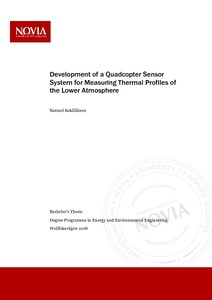Development of a Quadcopter Sensor System for Measuring Thermal Profiles of the Lower Atmosphere
Kekäläinen, Samuel (2016)
Kekäläinen, Samuel
Yrkeshögskolan Novia
2016
All rights reserved
Julkaisun pysyvä osoite on
https://urn.fi/URN:NBN:fi:amk-201604285322
https://urn.fi/URN:NBN:fi:amk-201604285322
Tiivistelmä
Detta slutarbete gjordes för Novias FOU avdelning vid Wolffskavägen. I slutarbetet planerades och skapades ett temperaturmätningssystem för att mäta temperaturer i lägre atmosfären (0 to 150m). Detta var uppnått genom att sätta fast en minidator och en temperatursensor på en quadcopter kapabel till att flyga automatiskt.
Egenskaperna på detta mätningssystem undersöktes i labb och i fält. Processen hur temperaturmätningssystemet lades ihop beskrivs, och ett antal mindre program och skript menade att hantera data och styra temperaturmätningssystemet likaså. Praktiska saker man bör betänka då man flyger quadcopters i förhållanden som systemet är tänk att flyga i behandlas. This thesis was made for the R&D department of Novia, Wolffskavägen. A temperature measurement system for measurements in the lower atmosphere (0 to 150m) was devised. By the use of a temperature sensor and a miniature computer strapped onto a quadcopter capable of independent flight this was achieved.
The properties of the resulting temperature measurement system were tested in both lab and real conditions. The process of putting together the temperature measurement system physically was described as were various minor software solutions to process and summarize the data as well as to operate the temperature system. Implications of flying quadcopters in the conditions required of the system were explored.
Egenskaperna på detta mätningssystem undersöktes i labb och i fält. Processen hur temperaturmätningssystemet lades ihop beskrivs, och ett antal mindre program och skript menade att hantera data och styra temperaturmätningssystemet likaså. Praktiska saker man bör betänka då man flyger quadcopters i förhållanden som systemet är tänk att flyga i behandlas.
The properties of the resulting temperature measurement system were tested in both lab and real conditions. The process of putting together the temperature measurement system physically was described as were various minor software solutions to process and summarize the data as well as to operate the temperature system. Implications of flying quadcopters in the conditions required of the system were explored.
